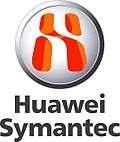Huawei Symantec
Huawei Symantec Technologies Co. Ltd. (Chinese: 华为赛门铁克科技有限公司; pinyin: Huáwéi Sàiméntiěkè Kējì Yǒuxiàn Gōngsī) was a developer, producer and supplier of network security, storage and computing solutions. The joint venture was disbanded in March 2012 [1][2] when Symantec sold its share in the company to Huawei, which is headquartered in Chengdu, China.[3][4] Huawei originally owned 51% of the company, while Symantec owned 49%.
 To build a harmonious information world | |
Native name | 华为赛门铁克科技有限公司 |
|---|---|
| Joint venture | |
| Industry | Information Technology |
| Fate | Symantec's stake acquired by Huawei |
| Founded | February 2008 |
| Defunct | March 2012 |
| Headquarters | , |
Key people | Chairman Ren Zhengfei, CEO Tad Lebeck, CTO |
| Owners | Huawei (51%) Symantec (49%) |
| Website | www |
Huawei is a Chinese-based company, while Symantec Corporation (NASDAQ: SYMC) is a US-based corporation headquartered in Mountain View, California.[5]
History
- 2000: Huawei started R&D in the security technology field; Symantec is a provider of antivirus and security software
- 2004: Huawei started R&D in storage technology field
- 2005: Symantec acquires Veritas Software, manufacturer of Information Lifecycle Management software
- 2007 (May): Huawei and Symantec sign an agreement for the establishment of a joint venture in order to provide end-to-end solutions in the domain of converging network, security, and storage and computing technologies.[6]
- 2008 (February): Huawei Symantec was established.
- 2012 (March): Huawei acquires the 49% of shares held by the Symantec Corporation at a price of about 530 million U.S. dollars or 3.4 billion yuan.
Technological convergence and R&D
Huawei Symantec is a holder of more than 300 patents in storage and network security field, and about 30 of them were accepted as formal technological standards.[7] Huawei Symantec's technologists participate in various standardization organizations, including holding chair and vice-chair posts.[8] More than 50% of employees are engaged in research and development activities with labs located in Beijing, Shenzhen, Hangzhou in China, and in India.[9]
Acquisition by Huawei
On November 14, 2011, Beijing Time, Huawei and Symantec reached an agreement on a transaction where Huawei acquired Symantec's 49% stake in Huawei Symantec Technologies Co., Ltd. (Huawei Symantec) for US$530 million.[10] Upon closing the agreement gave Huawei full ownership of Huawei Symantec. Huawei Symantec and Symantec Corporation are two separate entities.
References
- "Huawei – Symantec, broken join venture and the fear on chinese firms". Retrieved 2013-04-22.
- Perlroth, Nicole; Markoff, John (2012-03-26). "Symantec Dissolves a Chinese Alliance". The New York Times. Retrieved 2013-04-22.
- Jander, Mary (2007-05-23). "Huawei & Symantec Make It Official". Byte and Switch. Archived from the original on 14 February 2009. Retrieved 14 February 2009.
- "Contact Us – Huawei Symantec". Huawei Symantec. Archived from the original on 2009-02-14. Retrieved 2009-02-14.
- "Huawei, Symantec joint venture gets EU go-ahead". Xinhua News Agency. 2007-12-21. Archived from the original on 14 February 2009. Retrieved 14 February 2009.
- Tan, Lynn (2007-05-22). "Huawei, Symantec forge joint venture". ZDNet. CBS Interactive. Archived from the original on 14 February 2009. Retrieved 14 February 2009.
- Xinchun, Peng. "Huawei Symantec: A Pilot of Storage and Network Security Solutions in the Information Era". Huawei Symantec. Archived from the original on 2009-02-14. Retrieved 2009-02-14.
- "Corporate Briefing Of Huawei Symantec (2008)". Huawei Symantec. 2008. Archived from the original on 2009-02-14. Retrieved 2009-02-14.
- "Huawei Symantec Overview". Huawei Symantec. Archived from the original on 2009-02-14. Retrieved 2009-02-14.
- "Huawei Acquires Symantec Stake in Huawei Symantec Joint Venture". Symantec. Retrieved 2011-12-02.